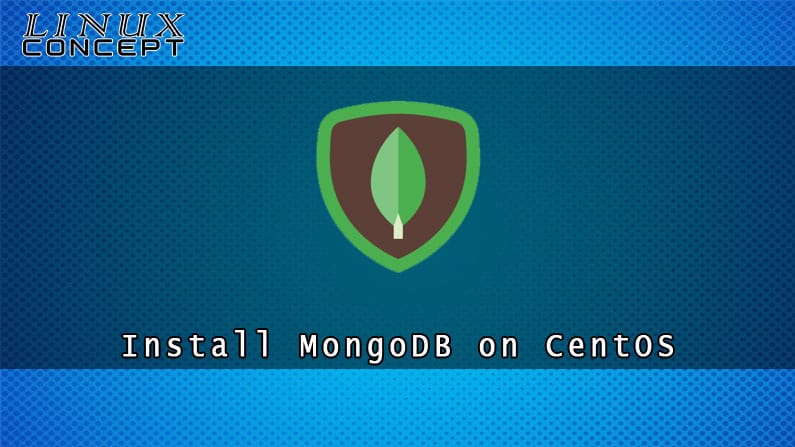MongoDB is an open-source and free NoSQL document based database system. Nowadays, it is prevalent as most application developers are using MongoDB, which can handle big data.
As a MongoDB is a NoSQL database, It stores data in JSON-like documents where fields can vary. You also get benefits with MongoDB like it doesn’t require any predefined database schema or data structure; it can be changed over time.
In this tutorial, we will explain the process of MongoDB installation step-by-step on CentOS 8 Linux using MongoDB’s official repositories.
Prerequisites
Before starting the installation and configuration process, make sure you have CentOS 8 installed system with sudo privileged user access to execute administrative commands.
Installing MongoDB
Here we follow a few steps to install MongoDB on the CentOS system.
Step 1 – MongoDB official repositories enable
To enable mongodb repository on CentOS we need to create a yum repos file for mongodb with name of mongodb-org.repo in the /etc/yum.repos.d/ directory using the following content:
[mongodb-org-4.0] name=MongoDB Repository baseurl=https://repo.mongodb.org/yum/redhat/$releasever/mongodb-org/4.0/x86_64/ gpgcheck=1 enabled=1 gpgkey=https://www.mongodb.org/static/pgp/server-4.0.asc
Step 2 – Install MongoDB
After enabling the MongoDB repository, you can update the apt package list and install the mongodb-org package like any other package we are installing on CentOS, as shown below:
$ sudo yum update
$ sudo yum install mongodb-orgThe mongodb-org package will install all below package related to mongodb:
- Mongodb-org-server – It is for MongoDB daemon (mongod) and init script along with configuration
- Mongodb-org-mongos – It is for mongos daemon or service.
- Mongodb-org-shell – The mongo shell provides a JavaScript interface to MongoDB, which is used to perform administrative tasks using the command-line.
- Mongodb-org-tools provides several tools for mongodb to import and export data, check the data statistics, and have various other utilities.
Step 3 – Start MongoDB service
After completion of MongoDB installation, you can use the following command to start MongoDB service and enable the service to auto-start on system boot:
$ sudo systemctl start mongod
$ sudo systemctl enable mongodStep 4 – Verify the Installation
To verify the MongoDB has successfully installed in the system, you should connect to the mongoDB database server using the mongo command, which will print the connection status where you can check the version of MongoDB, as shown below:
$ mongoOnce you get the mongo shell, type the following command to print the mongodb version:
db.version()Output:
MongoDB shell version v4.0.10
connecting to: mongodb://127.0.0.1:27017
MongoDB server version: 4.0.10
{
"authInfo" : {
"authenticatedUsers" : [ ],
"authenticatedUserRoles" : [ ]
},
"ok" : 1
}In the above output message, the value of 1 for the ok field indicates success.
Configuring MongoDB
You can edit /etc/mongod.conf file to configure MongoDB instance. It is a YAML formatted configuration file.
The preconfigured or default settings is enough for most of the users. Still, to run MongoDB in production, it is recommended to uncomment the security configuration and enable settings for authorization, as shown below:
security: authorization: enabled
The authorization option provides Role-Based Access Control (RBAC) to provide access control for users on database resources and operations. Ig authorization is disabled, means each user having access to all database for performing any action.
After changing the configuration of the MongoDB server on the configuration file, need to restart mongod service to take new settings using the following command:
$ sudo systemctl restart mongodYou can find more option related to MongoDB configuration at Configuration file options on the documentation page.
Creating MongoDB Administrative User
If you have enabled the authentication in your MongoDB instance, you should create an administrative user to access and manage your MongoDB instance.
To create a user, first, you need to access the mongodb shell using the following command:
$ mongoOnce you get the MongoDB shell, use the following command to connect with the admin database:
use adminOutput:
switched to db adminTo create a user in MongoDB, you need to use the below command, where mongoAdmin is the username, and userAdminAnyDatabase is for User role:
db.createUser(
{
user: "mongoAdmin",
pwd: "changeMe",
roles: [ { role: "userAdminAnyDatabase", db: "admin" } ]
}
)
Output:
Successfully added user: {
"user" : "mongoAdmin",
"roles" : [
{
"role" : "userAdminAnyDatabase",
"db" : "admin"
}
]
}You can exit the mongodb shell using the following command:
quit()You can test new user credentials and access by using mongo shell to log in for the new user, as shown below:
$ mongo -u mongoAdmin -p --authenticationDatabase adminuse adminOutput:
switched to db adminTo get the information about users in the mongo shell, use the following command:
show usersOutput:
{
"_id" : "admin.mongoAdmin",
"user" : "mongoAdmin",
"db" : "admin",
"roles" : [
{
"role" : "userAdminAnyDatabase",
"db" : "admin"
}
],
"mechanisms" : [
"SCRAM-SHA-1",
"SCRAM-SHA-256"
]
}Conclusion
You have learned MongoDB installation and configuration in your CentOS 8 machine. To learn more about MongoDB, you can visit the MongoDB manual page.
If you have any problem with the installation or having any feedback, please comment below.


0 Comments